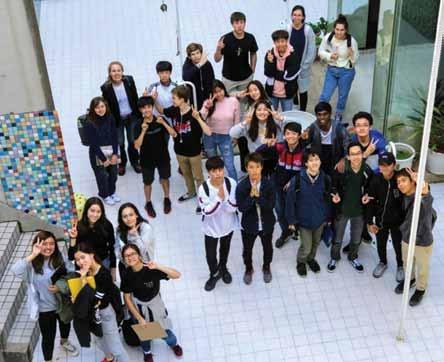
2 minute read
Investigation
Open and International Mindedness Through Investigation
By Tara Cheney
Students at Osaka International School of Kwansei Gakuin recently visited the Osaka Exchange and the Osaka International Peace Museum as part of their annual assessment investigation requirements in MYP integrated humanities and IBDP History.

Students analyse market fluctuations.
A first time presentation in English was given by the Japanese staff at the Osaka Exchange, including an overview of the history of the exchange from feudal times to its current day operations. The highlight of the investigation was participating in a simulation of buying and selling stocks, futures and options according to recent news updates. While every student wanted to make the most money they were also learning about market reaction according to the national and global news cycle. The simulation illustrated George Walker’s key components in an international school curriculum: “The capacity and motivation to consider issues from a global as well as a national perspective, understanding and respecting other opinions, acquiring skills of negotiation and compromise.”1 This simulation had a lasting impact on the students, as they now understand the importance of news items and their influence on the market.
At the Osaka International Peace Museum, many of our students were able to use their bilingual/ trilingual skills in deciphering the curated information. Sometimes information was not translated and so the students knowledge regarding Japanese kanji became imperative in examining the bias/ propaganda that the museum presented, for example, the lack of acknowledgement of foreigners that died during the bombing of Osaka, in WWII. The museum’s conservative government agenda provided scope for the students to develop investigative research questions delving into why various biases are present within the museum. It is through this type of investigation that our students fulfill George Walker’s last component of what a truly international school curriculum is: “Critical thinking skills that help the student to reflect on the nature of knowledge, its origins, reliability and on different criteria for truth.”2 (Walker, 2017)
The grade 11 IBDP History students also used the museum field trip to develop their critical thinking skills as historians, such as, selecting and analysing a range of source material and considering diverse perspectives. These students are tasked with searching for, selecting, evaluating and using evidence to reach a relevant conclusion in their investigation. They have to consider the origin, purpose and content when they are discussing the values and limitations of each source. It is through this model for analysing sources that an internationally minded approach becomes the usual modus operandi for our students. As Merryfield states, this investigative field trip created the opportunity for open mindedness to develop by giving students the opportunity to “...rethink assumptions, identify misinformation, and consider alternative ways to make decisions.”3 OIS students were able to better understand economic, historic, geographic, political and technological contexts that form their increasingly interconnected world.
First meeting with professors.
Our students at the Osaka International Peace Museum.
Bibliography Merryfield, M.M.,’Four Strategies for Teaching Open-Mindedness’, Social Studies and the Young Learner, vol.25,no.2,2012, pp,18-22
Walker, G., ‘What is an international school’, John Catts internationalschoolsearch.com, 2 7 April 2017, para. 12,16, <https://www. internationalschoolsearch.com/news/whatis-an-international-school>
1 G.Walker, ‘What is an international school’, John Catts internationalschoolsearch.com, 27 April 2017, para. 12, <https://www.internationalschoolsearch.com/news/what-is-an-international-school> 2 G.Walker, ‘What is an international school’, John Catts internationalschoolsearch.com, 27 April 2017, para. 16, <https://www.internationalschoolsearch.com/news/what-is-an-international-school> 3 M.M.Merryfield,’Four Strategies for Teaching Open-Mindedness’, Social Studies and the Young Learner, vol.25,no.2,2012, pp,18-22










